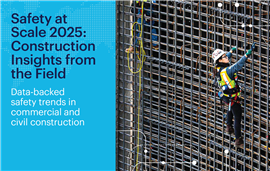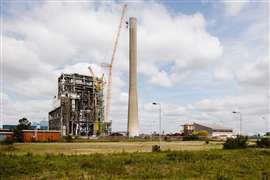Read this article in Français Deutsch Italiano Português Español
What 75,000 incidents reveal about construction safety
06 October 2025
A new global report has analysed more than 75,000 jobsite incidents, providing data-driven insight into when, how, and why construction workers get hurt and what contractors can do about it.
 HammerTech’s ‘Safety at Scale’ survey and report. Image courtesy HammerTech
HammerTech’s ‘Safety at Scale’ survey and report. Image courtesy HammerTech
Safety at Scale 2025, published by Australia-based safety software firm HammerTech, draws on six years of incident data across North America, Australia/New Zealand, and Europe.
While the report is not a global benchmarking tool, its findings highlight clear patterns that contractors can use to refine their safety programs and anticipate risks before they occur.
Morning spike, afternoon climb
The analysis confirms what many superintendents suspect: incidents surge an hour into the workday and after breaks.
Sites see the sharpest spike around 9am, just after crews have begun full activity.
“More injuries are recorded at 9am than at any other time of the day,” says the report. “It’s not an overwhelming spike, but it’s consistent enough to warrant attention.
“This timing generally sits just after site start-up, when crews are mobilised, work has ramped up, and early planning is giving way to physical tasks. In many regions, it also coincides with the first scheduled break.”
After a midday dip, injuries climb again in the afternoon, coinciding with fatigue and scheduled breaks.
Paul Duck, senior safety director for US-based Holder, contributes to the report. He says, “Most of our incidents were actually happening after lunch. It keyed us into a gap: we weren’t revisiting the pre-task plan after breaks.”
For contractors, the data suggests toolbox talks and supervision may be best timed to coincide with these high-risk windows, rather than solely at the start of shift.
The report states, “The timing of incidents strongly correlates with workforce rhythm: a sharp increase after site start, a midday dip, and a secondary rise as fatigue and task load peak. That could mean scheduling toolbox talks just before peak windows, delaying high-risk work starts, or increasing supervisory presence during those times.”
Struck-by and falls the most common incident
Across regions, the most common incidents involve struck-by accidents, falls, and contact injuries. The survey found 33% of injuries were caused by a worker coming into contact with an object, just less than 17% were hit by moving objects and 12.5% were injured from a fall (including trips and slips).
“The categories are consistent, but the circumstances behind them are numerous, from the tools in use to the site environment, work sequencing, or crew experience,” says the report. “
These are not isolated hazards but often a symptom of crowded work zones, overlapping trades, or accelerated schedules.
According to the report, “Project context also plays a role, with injury profiles varying by project type. For example, a data centre with high glove compliance can look very different to the fall risks common on high-rise builds. And richer, structured data - down to the body part and activity involved - is making it easier to act on these nuances, from refining PPE to adjusting workflows.”
The report argues that prevention lies in new PPE regulations, better sequencing and improved site coordination; areas where general contractors and project managers can have direct influence.
Peter Byrne, EHS director at Ireland-based Conack, says, “We’re tracking injuries by body part to identify trends. Hands and arms are among the most common, so we’ve been able to refocus toolbox talks and whiteboard meetings on preventing hand injuries ,enforcing glove use, for example.
“Most importantly, we’ve been able to shift the conversation from simply ‘wear gloves’ to choosing the right glove types for different trades.”
A positive shift in reporting culture
One of the strongest trends is an increase in incident reporting. More near-misses and minor events are being logged, creating a clearer picture of risk but also placing added administrative burden on supervisors.
The report notes: “The steady rise in reported incidents signals a culture shift toward visibility. Increased reporting does not necessarily mean more risk, but rather more transparency in risk identification.
“Across the same six-year dataset, one trend stands out: the number of injuries relative to the number of incidents reduced by 23% over time (2018 to 2024). Even as reporting has increased, fewer incidents now involve harm – highlighting a widening gap between reporting activity and injury outcomes.”
Mike Gloria, senior safety manager at US-based Power Construction, notes, “What we’ve seen on our own projects over the last three-plus years [is] more incident reports submitted, but at the same time, our actual injury numbers are going down. So, while reporting volume has gone up, the number and severity of injuries have both gone down.”
The data underlines the value of capturing every incident and near miss - not just government-mandated recordables - to build a predictive view of site risk.
Implications for contractors
For some contractors, the industry context is clear: safety investment is increasingly tied to project efficiency.
Fewer injuries mean fewer delays, reduced insurance exposure, and stronger workforce retention. Owners are also beginning to fold safety performance into procurement and ESG reporting, putting added pressure on contractors to demonstrate progress.
The report concludes, “The challenge is not only in identifying incident patterns, but in reshaping site rhythms, supervision intensity, and task planning to intervene before those patterns repeat.
“Whether it’s refining morning briefings, focusing training, or targeting investments, the goal is the same: to ensure everyone gets home safely at the end of the day.”
STAY CONNECTED


Receive the information you need when you need it through our world-leading magazines, newsletters and daily briefings.
CONNECT WITH THE TEAM











